Val d´Orcia: the true Tuscany
When I say Tuscany, I think of green rolling countryside, endless vineyards, here and there a farmhouse and zigzag paths lined with tall trees, in short, the idyll from Googled photos. Finding vineyards in Italy is no mean feat, but only one area - Val d'Orcia - does the rest. I was completely enthusiastic about visiting this valley, and I rewrote the itinerary you may have read about in the previous article until I managed to fit in at least a day and night spent there.
The problem is that you don't read much about Val d'Orcia in Czech sources, and when you do, it's usually only a passing mention. So I searched for specific places on my own, either by randomly clicking on the map or reading foreign blogs. The second problem was the fact that the end of September is not exactly the best time to visit, which I hadn't quite figured out beforehand. Anyway, I'll break it down later, but first let's check out a town that you definitely can't miss on your way to the valley.
Siena
The capital of the Italian province of the same name and for us also an ideal starting point for a trip to Val d'Orcia. Siena was lucky enough not to have been bombed during the war and today boasts a beautifully preserved medieval centre and one of the oldest universities in the world, which are of course UNESCO World Heritage Sites. In general, I find Siena to be a very pleasant and relaxed city, inviting you to stroll around and enjoy a drink.

|

|

|

|
And there is one more interesting thing about the square. As you walk around Siena, you'll notice the multi-coloured flags hanging from buildings and souvenir stalls. The city is divided into 17 districts (contrade), each with its own flag... and a motto, a symbol, a church, etc... Originally, each contrade was dedicated to a different profession, and there was often animosity between the different parts. Only the piazza (and the cathedral) was declared neutral territory, where the contradas measure their strength in the prestigious Il Palio race. I believe it is quite difficult to imagine such a thing in the historic centre of the city. Anyway, the race is held on a specially built track only twice a year - on July 2 and August 16, and each time it is preceded by a historical allegorical procession = corteo storico. The race itself is run over 3 laps and beware... on unsaddled horses! Apparently the whole thing takes about a minute and a half, but it's not uncommon for horses to arrive at the finish line without riders.

|

|

|

|
Where to stay in Siena
-
cheaper: B&B Quattro Cantoni
- accommodation right in the centre of Siena offering different types of rooms, with prices starting from €48/night
- medium: Casacenti - well rated rooms again in the center, price about €68 with breakfast. But if you're not so keen on the centre, check out Hotel Santa Caterina with great views and service, prices from €80
- luxury: really difficult choice, because there are a lot of beautiful accommodations, so for example I will choose stylish apartments Casatorre dei Leoni Dimora Storica and Country Lodge B&B with garden and jacuzzi

Val d´Orcia
I would say that the best time to visit Val d'Orcia is spring to about the end of summer. In the spring months, the fields turn beautifully green and gradually turn golden, and by late August/September, the scattered straw bales on the slopes are another rewarding photo subject. But Val d'Orcia will have its charm all year round. We found ourselves here in the second half of September, when the fields were mostly ploughed and the bales harvested, and we still loved it. The character of the landscape here is simply unique, which is why it was designated a UNESCO site in 2004.
 |

|
How to get there?
A simple question with a simple answer - BY CAR. Don't even think about anything else, because here you really want to be free and stop at will. The valley lies below Siena, so there are two options:
- arrive by plane and rent a car - direct flights to Florence are operated by Vueling, while Ryanair is the cheapest option to Pisa. Ryanair used to fly to Florence as well, so we'll see if they renew the route in the future. Book your car rental before you go, just pick it up at the airport and you're good to go!
- arrive by car directly - our itinerary, including the fees associated with travelling by your own car from the Czech Republic, I've broken down with the first article, so it's up to you and your time to decide which route you prefer.

Where to stay?
Let me tell you, it was really hard to choose accommodation here and the reason is definitely not the lack of it. On the contrary! There are so many options here and even worse so many beautiful options that you won't know what to book first. In the end, my choice was Az.Agr. Il Cavalleggero, which has fantastic reviews and is also located a short walk from our last stop, Bagno Vignoni. There's a lovely setting with a lovely landlady, outdoor seating and horses grazing around, incidentally it's primarily a riding school so ideal for horse lovers. You'll be staying in nice stylish rooms and in the morning you'll have an absolutely LUXURY breakfast of homemade products - homemade bread, homemade granola, homemade fresh, homemade marmalade... well yummy, really!

|

|
Otherwise, of course, it depends on what places you'll be staying in, so here are my other accommodation tips. They're all beautiful, well rated and sort of similar in price. It's just worth getting a bit spoiled here... oh and sorry, but you really can't pick just one, or even just five :)
What not to skip?
- Agriturismo Baccoleno - a view of an absolutely exemplary zigzag avenue of cypress trees. The driveway is private, so you can't get to it, but you can leave your car by the main road (somehow reasonably, not to get in the way of course) and then walk a few dozen meters to the viewpoint, which the owners tolerate for now. Just follow the beaten path, you probably can't miss it if you know what you're looking for. You take the road called Strada Provinciale del Pecorile, leave the car at Crete Senesi vista and walk to the Viewpoint on Agriturismo Baccoleno.

|

|
- Cipressi di San Quirico d´Orcia - this place is not exactly a cypress alley, but a cypress circle... and there are two cypress circles! The first one is more just for a photo from a distance, as it is right in the middle of the field. On the other hand, you can check out the second one pretty close up, but you'll have to walk a bit to get to it. As for navigation, watch out here, google is making shit up here. The car park is called Parcheggio dei cipressi and it's just off the main SR2 road, but google maps will try to take you there in a total roundabout way and on some pretty crazy roads. So ignore it this time and stick to the main road. It's then about a 10 minute walk from the car park to the second cypress Cipressi Ring.

|

|
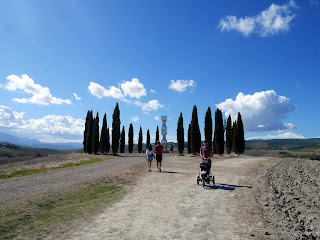
|

|
- Poggio Covili - this stop is going to be mega fast, because it's a private road again... even with a camera system and a chain... but what the hell, you stop right on the main road, run out, click, click, click, and you're on your way. Oh, and the cypress trees at Poggio Covili look great from a distance, see the photos below (taken on the way to Bagno Vignoni). Type Farmhouse Poggio Covili into google maps, that's all you need.
-
Parco de Mulini - the remains of ancient Roman baths, reservoirs, mills and a water channel through which hot water still flows. Ideal for getting your feet wet. The water then cascades into the pool below =>
-
Antiche Terme Romane Libere -
that collection pool with thermal water where you can take a free bath. The water here is a bit cooler than upstairs, but it was still cool enough that I got in there with Donut :) The access road is either from the top from the center of Bagno Vignoni or there is a side road from the bottom, which you then simply take back to the parking lot.
- staying in a hotel with its own thermal pool - yes yes, several hotels have thermal springs in their wellness areas. These are gorgeous and luxurious accommodations, so if you've come here to be pampered, you've come to the right place - Albergo Posta Marcucci or Adler Spa Resort.

|

|

|

|
Feel free to continue to the next article from our Tuscan roadtrip - How to plan Cinque Terre in one day.
If this information has helped you to save some time or money or both, you can "invite me for a coffee" and contribute to the running of Travel with Donuts :) account number / QR kód: 1257951017/3030


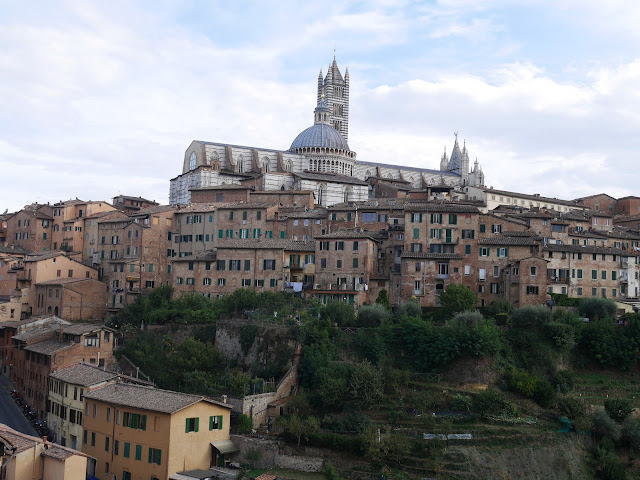
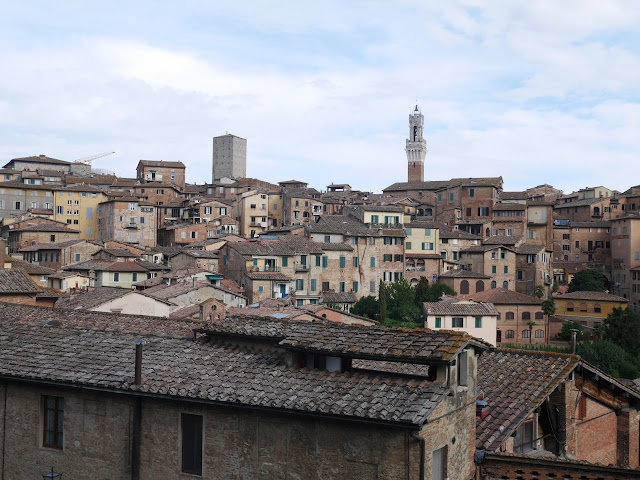







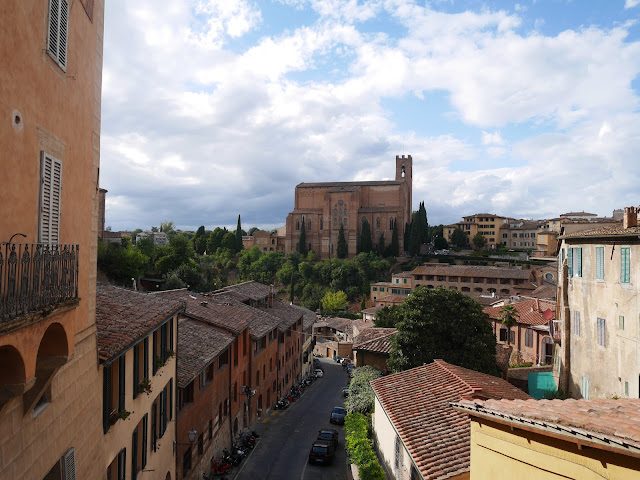





































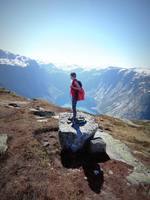





Žádné komentáře: